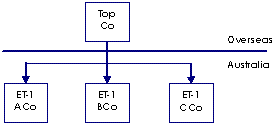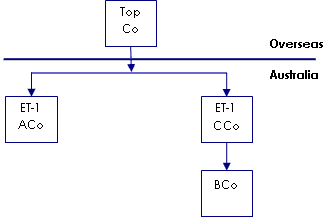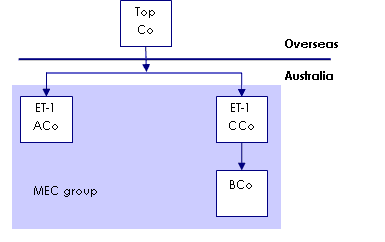Consolidation Reference Manual
You can still refer to the Consolidation reference manual for consolidation information that has not been impacted by changes in the legislation.
C2 Assets
C2-4 Worked examples - cost setting on entry
General
C2-4-105 Transitional entities and chosen transitional entities
Description
When a member of a consolidated or multiple entry consolidated (MEC) group qualifies as a transitional entity, the head company of the group may choose not to set the tax costs for the assets of that entity on the group's formation. Instead, the head company will inherit the existing tax cost of the assets. This example explains when a member can qualify as a transitional entity.
Commentary
Generally, when a consolidated or MEC group forms, the head company sets the tax cost for the assets of the subsidiary members (the 'spread' method). However, if the group forms during the transitional period (1 July 2002 to 30 June 2004), the head company may choose instead to retain the existing tax costs of a member that qualifies as a transitional entity (the 'stick' method). Such an entity is a chosen transitional entity.
Permitting the head company of a consolidated or MEC group to retain a chosen transitional entity's tax costs is a concession allowed to reduce compliance costs. For example, the head company need not obtain market values for the assets of a chosen transitional entity.
|
Note
Transitional foreign-held subsidiaries in MEC and consolidated groups and eligible tier-1 companies in MEC groups do not have the tax cost of their assets set. Therefore, it is not necessary to consider whether transitional foreign-held subsidiaries and eligible tier-1 companies are transitional entities. → 'Transitional provisions for foreign-held, Australian-resident subsidiaries to be members of a MEC group', C10-2-120 → section 701C-30 of the Income Tax Assessment (Transitional Provisions) Act 1997 (IT(TP)A) (on transitional foreign-held subsidiaries) and subsection 719-160(2) of the Income Tax Assessment Act 1997 (on eligible tier-1 companies). → Taxation Determination 2005/43 |
The conditions an entity must satisfy to qualify as a transitional entity will depend on the date the group formed, as follows:
A consolidated group formed on 1 July 2002:
Each entity that became a subsidiary member of the group on that day is a transitional entity. → subsection 701-1(1) of the IT(TP)A
A MEC group formed on 1 July 2002:
Each entity that became a subsidiary member of the group on that day is a transitional entity. → subsection 701-1(1) of the IT(TP)A as modified by section 719-2
A consolidated group formed after 1 July 2002 and before 1 July 2003:
- •
- An entity must have been a wholly-owned subsidiary of the prospective head company on the formation date, and
- •
- during the period 1 July 2002 to the formation date, the entity must not have ceased to be a wholly-owned subsidiary of the prospective head company and then again become its wholly-owned subsidiary.
→ subsection 701-1(2) of the IT(TP)A
A MEC group formed after 1 July 2002 and before 1 July 2003:
- •
- An entity, on the formation date, must have been a wholly-owned subsidiary of the entities that became members of the MEC group as eligible tier-1 companies at the time the group formed, and
- •
- during the period 1 July 2002 to the formation date, the entity must not have ceased to be a wholly-owned subsidiary of these entities and then again become their wholly-owned subsidiary.
In applying this test, the entity is treated as a wholly-owned subsidiary, at a particular time, of the entities that became members of the MEC group as eligible tier-1 companies if all of the membership interests in the entity were directly or indirectly held by one or more of these entities at that time.
→ subsection 701-1(2) of the IT(TP)A as modified by subsection 719-161(2)
A consolidated group formed during the financial year starting 1 July 2003:
- •
- The entity must have been a wholly-owned subsidiary of the prospective head company just before 1 July 2003, and
- •
- during the period 1 July 2002 to the formation date, the entity must not at any time have ceased to be a wholly-owned subsidiary of the prospective head company and then again become its wholly-owned subsidiary.
→ subsection 701-1(3) of the IT(TP)A
A MEC group formed during the financial year starting 1 July 2003:
- •
- The entity must have been, just before 1 July 2003, a wholly-owned subsidiary of the entities that became members of the MEC group as eligible tier-1 companies at the time the group formed, and
- •
- during the period 1 July 2002 to the formation date, the entity must not at any time have ceased to be a wholly-owned subsidiary of these entities and then again become their wholly-owned subsidiary.
In applying this test, the entity is treated as a wholly-owned subsidiary, at a particular time, of the entities that became members of the MEC group as eligible tier-1 companies if all of the membership interests in the entity were directly or indirectly held by one or more of these entities at that time.
→ subsection 701-1(3) of the IT(TP)A as modified by subsection 719-161(2)
A MEC group formed during the financial year starting 1 July 2003 where the membership interests in an eligible tier-1 company have been transferred to another eligible tier-1 company before formation:
An eligible tier-1 company of a potential MEC group whose membership interests were transferred to one or more other eligible tier-1 companies of the group at a particular time (the transfer time) so that it was a wholly-owned subsidiary of those eligible tier-1 companies when the MEC group formed may still qualify as a transitional entity. The transferred entity will be a transitional entity if it satisfies the following conditions:
- •
- it and one or more other entities must have been members of the potential MEC group as eligible tier-1 companies continuously from just before 1 July 2003 until the transfer time, and
- •
- after the transfer, it remained a wholly-owned subsidiary of one or more of the eligible tier-1 companies until the formation time, and
- •
- the other eligible tier-1 companies remained members of the potential MEC group as eligible tier-1 companies continuously from just before 1 July 2003 until the formation time, and
- •
- the other eligible tier-1 companies became members of the MEC group as eligible tier-1 companies when the group formed.
→ subsection 719-161(3) of the IT(TP)A
Subsection 719-161(3) of the IT(TP)A was also intended to achieve the following outcomes:
- •
- An eligible tier-1 company whose membership interests are transferred in the circumstances described above remains a transitional entity if the choice to consolidate is made under section 703-50 (concerning consolidated groups) rather than section 719-50 (concerning MEC groups).
- •
- Whether the choice to consolidate is made under section 703-50 (concerning consolidated groups), or section 719-50 (concerning MEC groups), a wholly-owned subsidiary of an eligible tier-1 company transferred in the circumstances described above will also be a transitional entity if:
- -
- the subsidiary was a wholly-owned subsidiary of the transferred eligible tier-1 company just before 1 July 2003, and
- -
- it remained a wholly-owned subsidiary of the eligible tier-1 company continuously from the earliest time it became a wholly-owned subsidiary of the eligible tier-1 company after 1 July 2002 until the time the election to consolidate is made.
Example

ACo, BCo and CCo are eligible tier-1 companies of the top company Top Co (Figure 1). Just before 1 July 2003, ACo, BCo and CCo are members of a potential MEC group.
On 30 September 2003, Top Co transfers all its membership interests in BCo to CCo. After the transfer, BCo is a wholly-owned subsidiary of CCo (Figure 2).

On 1 December 2003, ACo and CCo, as eligible tier-1 companies, choose to form a MEC group. The members of the MEC group are ACo, BCo and CCo. ACo is the provisional head company (PHC).

BCo qualifies as a transitional entity in the MEC group. ACo may choose for BCo to be a chosen transitional entity. → section 701-5 of the IT(TP)A as modified by section 719-2 of the IT(TP)A
References
Income Tax (Transitional Provisions) Act 1997, Section 701-1 and 719-161
Explanatory Memorandum to the New Business Tax System (Consolidation, Value Shifting, Demergers and Other Measures) Bill 2002, paragraphs 1.75 to 1.87
Explanatory Memorandum to the Tax Laws Amendment (2004 Measures No. 2) Bill 2004, paragraphs 2.107 to 2.117
History
Revision history
Section C2-4-105 first published 16 December 2005.
Proposed changes to consolidation
Proposed changes to consolidation announced by the Government are not incorporated into the Consolidation reference manual until they become law. In the interim, information about such changes can be viewed at:
- •
- http://assistant.treasurer.gov.au (Assistant Treasurer's press releases)
- •
- www.treasury.gov.au (Treasury papers on refinements to the consolidation regime).
Current at 16 December 2005
